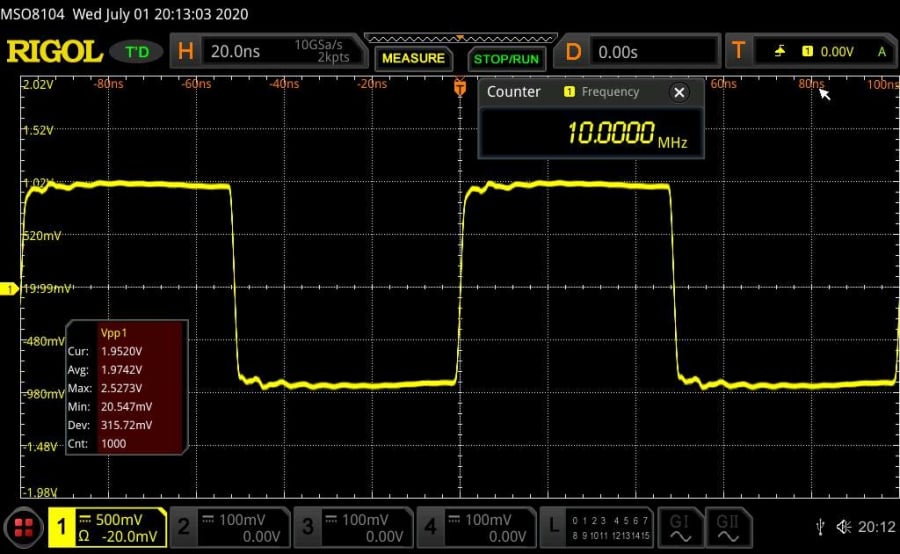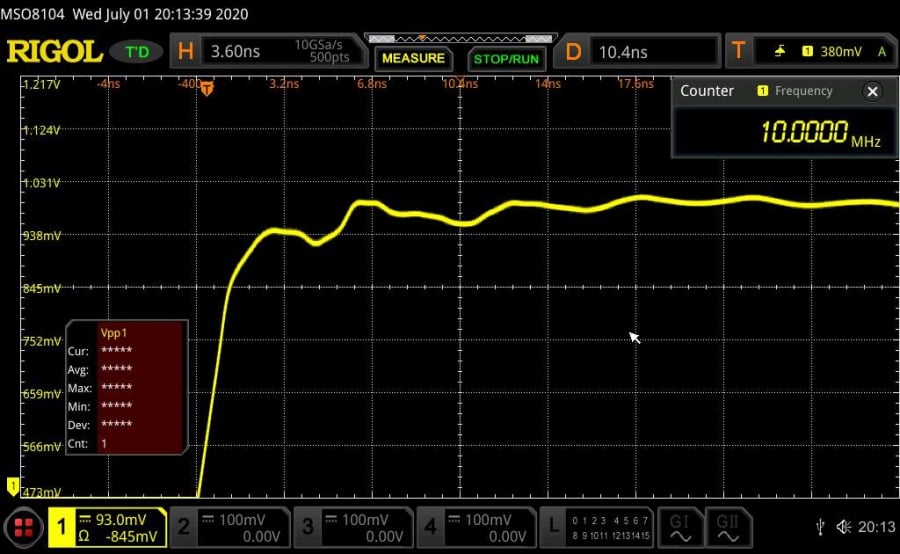Bigman80
Grandmaster
 The HiFi Bear/Audioaddicts/Bigbottle Owner
The HiFi Bear/Audioaddicts/Bigbottle Owner
Posts: 16,398
|
Post by Bigman80 on Dec 14, 2020 15:28:26 GMT
For a long time now, i have been using an Orchard Audio PecanPi. This has been a route into accepting Digital as a bonafide method of playback that could rival vinyl. In fact it surpasses that of some vinyl systems i have experienced. The ability to play the files stored on the SSD without having to use a computer was something i wanted right back in the early days of my HiFi journey. At the time i had the original NOS TeraDac, and regardless of the rave reviews, i thought it sucked. Flabby bass. Overblown mid-bass and tingly treble...like i had pins and needles in my ears. It was not what i would call....audio. The first foray back into the Digital world after the "Tera-Cack" was with a M2Tech Young DAC. Fed via USB from the laptop, it was actually pretty good. I just couldn't use it how i wanted to. I wanted to store my files on a HDD and control it from my laptop or phone. I decided to do some research. Then up popped the first of it's kind that i had ever seen.....the "Gramofon streamer" Yes....never heard of that one have you!! Have a look here: www.stuff.tv/my/news/gramofone-music-streamer-makes-your-dumb-speakers-smartThis device was revelatory to me. I could do pretty much everything i wanted to, and you know what.....it sounded pretty good too. I used that fleetingly as i was heavily focused on pushing my analogue front end forward. One day, it just died. It wouldn't connect to anything and to my horror, i couldn't find any more. In the time i had owned it (12 months-ish) the company seemed to have disappeared. Bugger. I kept my eyes open for something similar but as time went on, i stopped looking. My Analogue was starting to really come on and my feelings were that Digital couldn't lay a glove on this! I was right....and wrong at the same time. FFW a few years and mikeyb was talking about the "Allo Boss" on AoS. I had no clue as to what it was, other than it played media. "Great" i'll have a look. Sure enough, Mikey loaned me his Allo stuff and i suddenly had all the functionality i had with the Gramofone, but it sounded fantastic! So much so that those that heard it bought one too. The Katana followed...and went back. It wasn't great. Then the PecanPI.....WOW. I have loved it from the moment i heard the second one. Yup, first one had a digital noise, but i could hear the potential. LPSU's were added. CMC sockets too....it was and is a superb listen. But the issue for me was that i knew the RPI was holding it back. I asked about a standalone version of the PecanPI and to his credit, a few months later a PecanPI USB DAC came out. I decided to modify my own with Leo's instruction, but i couldn't get the USB input to talk to the laptop. £80 down the drain and still bound to the RPI. Then, i read about the Soekris R2R DAC. I always wanted to try a R2R and was convinced the Denafrips Pontus would be what i bought. Fate had it that i would instead go for the Soekris. Now, all i needed was a way to control the file transfer system the way i wanted to. This part has always been the tricky bit. Yes, a tinkerboard would do it, as would a RPi but i wanted to get away from those formats and try a purpose built unit. My droidbox demonstrated via Toslink that i was right. USB isnt an option, so that ruled out the Innuos, the SotM and others. I wanted a Coaxial connection. I was looking at Audiolab 8000N, cambridge CXN.....loads of them. None of which were in my budget or took my fancy. Tony suggested a NovaFidelity. I know what you're thinking, but he did so on the basis that he uses the NovaFidelity X50D. Kindly, he offered to loan me the N15D, which is the entry level unit. I took him up on the offer and i am glad i did. The N15D is a very interesting unit. Watching the vids and reading the blurb, it seems the units through out the range share the same technology. whereas with other brands the entry level unit is usually Sh#t, this one is not bad at all. After hearing Tony's system, the thing that stood out most to me, is the clear lines and space. This borne from a total lack of distortion and having an ultra low noise floor. I did wonder when listening to it about how much the NFX50D actually contributed to the overall sound. It's by far the cheapest piece in the chain, so it's not unfair to think it isn't that integral. Wrong The N15D has enabled the Soekris to perform beyond the levels of any digital audio i have heard in my system, or that of any other normal system (Tony's and other mega bucks systems not included) The clear lines and space have followed the N15D from Tonys system into mine! Why? well lets start here: I am two hours into this unit being fresh out of the box and in that time, i am hearing space in the soundstage. Improved (hugely) decay. Quiet passages of music seem to be even more delicate. The dynamics and impact has gone up in orders of magnitude. The low Frequency detail and control is tight...pinpoint and explosive. Listening to "The Wall" and "best days of our lives" in particular, and i am recalling the speed and instantaneous stopping and starting of the drums in this track, and how this LP in Angus's system (when he had the metal driver laden Monitor Audios) was the fastest i had ever heard it..... not anymore. Speed.....pure speed under total control. No smearing. No overhang. Wowsers! If i hadn't been there myself, i would swear someone changed the DAC. It was night and day differences. It's early days here, and the unit needs about 80hrs apparently before it's at its best. Just 78 to go. I am of the firm belief that the RPI and droidbox, whilst capable of putting out the required data, are absolutely out of their depth vs a unit like this. I am mega impressed and can't wait to get some more listening done. I will share more thoughts when i have got some. |
|
|
|
Post by mikeyb on Dec 14, 2020 15:59:44 GMT
I've looked at these before but comments regarding the user interface has always put me off.
I nearly bought one of the 40/45/50 models to try, but in the end the thought too many eggs in one basket held me back.
Have you tried it with the built in DAC or did you go straight to the Soekris.
|
|
Bigman80
Grandmaster
 The HiFi Bear/Audioaddicts/Bigbottle Owner
The HiFi Bear/Audioaddicts/Bigbottle Owner
Posts: 16,398
|
Post by Bigman80 on Dec 14, 2020 16:01:11 GMT
I've looked at these before but comments regarding the user interface has always put be off. I nearly bought one of the 40/45/50 models to try, but in the end the thought too many eggs in one basket held me back. Have you tried it with the built in DAC or did you go straight to the Soekris. Straight to the Soekris. Not sure what the I terrace would be off putting? It's very similar to Volumio on the app...just a bit less polished |
|
Bigman80
Grandmaster
 The HiFi Bear/Audioaddicts/Bigbottle Owner
The HiFi Bear/Audioaddicts/Bigbottle Owner
Posts: 16,398
|
Post by Bigman80 on Dec 15, 2020 17:50:28 GMT
Setting the scene: Just dropped the knackered body into the listening chain to place a Farnell order and thought i would pop the system on for an hour while i do the bit's and pieces. In the room is my oscillosope....with 75ohm BNC to RCA cables with adaptors......AH!, ill stick them in between the NFN15D and the Soekris.....holy Sh#t! I knew the Toslink was an "undesirable" connection, but the SPDiF has absolutely demolished it!!! This is crazily 3D dimensional, almost holographic and totally different to where it was just yesterday? What is this wizardry? Listening to Norman Greenbaum - Spirit in the Sky and im laughing my head of because it's SO DETACHED FROM ANYTHING I HAVE HEARD FROM DIGITAL I HAVE EXPERIENCED HERE!!! The Yammies have come alive!!! WTF am i doing here?  This track.......where has this come from?  ? My heads gone......I'll try and make sense later |
|
|
|
Post by stevew on Dec 16, 2020 18:36:04 GMT
Just curious really... but have you tried the internal dac yet?
|
|
Bigman80
Grandmaster
 The HiFi Bear/Audioaddicts/Bigbottle Owner
The HiFi Bear/Audioaddicts/Bigbottle Owner
Posts: 16,398
|
Post by Bigman80 on Dec 16, 2020 19:45:22 GMT
Just curious really... but have you tried the internal dac yet? No, not yet but I will. |
|
Bigman80
Grandmaster
 The HiFi Bear/Audioaddicts/Bigbottle Owner
The HiFi Bear/Audioaddicts/Bigbottle Owner
Posts: 16,398
|
Post by Bigman80 on Dec 17, 2020 20:15:31 GMT
SO, I have just spend an hour or so comparing the inbuilt Sabre DAC with the Soekris. Needless to say i won't be doing that again in a hurry.
The Sabre sounding surprisingly lifeless and flat. No soundstage depth and what felt like a real lack of dimension. seriously unimpressed.
Dropped the Soekris back in and was greeted with an abundance of texture, dimensionality and life! Vocals have an uncanny sense of realism and listening to John Van Der Veer now is like listening to the real thing. It's by far the best DAC i have heard with my own ears.
The Soekris is a seriously good DAC but make no mistake, the N15D is a huge reason for the sound quality i am getting.
HOWEVER....all is not quite rosy. Every now and again, i get like a little "peak or spitting like noise" and lose sound for a fraction of a second. It's doing my head in. This seems to happen on SPdif. Haven't tried it on USB but it wasn't happening on Toslink. I also don't know if its the DAC or N15D. I am using a genuine measurement grade BNC 75ohm cable with RCA adapters on.
Any ideas?
|
|
|
|
Post by macca on Dec 17, 2020 20:30:40 GMT
That does happen with coax occasionally because it's crap. There's nothing you can do about it as far as I know except swap to TOSlink or USB (if an option).
|
|
Bigman80
Grandmaster
 The HiFi Bear/Audioaddicts/Bigbottle Owner
The HiFi Bear/Audioaddicts/Bigbottle Owner
Posts: 16,398
|
Post by Bigman80 on Dec 17, 2020 20:40:14 GMT
That does happen with coax occasionally because it's crap. There's nothing you can do about it as far as I know except swap to TOSlink or USB (if an option). Really?  Are you serious? Thats gonna piss me right off. nothing like being fully absorbed and then it disappearing for a second. |
|
|
|
Post by firebottle on Dec 17, 2020 21:44:55 GMT
Adapters are not great. They can vary in quality enormously.
|
|
Bigman80
Grandmaster
 The HiFi Bear/Audioaddicts/Bigbottle Owner
The HiFi Bear/Audioaddicts/Bigbottle Owner
Posts: 16,398
|
Post by Bigman80 on Dec 17, 2020 22:04:57 GMT
Adapters are not great. They can vary in quality enormously. Think that could be an issue? |
|
|
|
Post by macca on Dec 17, 2020 22:14:47 GMT
Yes, no question.
|
|
|
|
Post by sq225917 on Dec 17, 2020 22:18:34 GMT
You can put whatever adaptors you like on em, unless its coax cable it will never be 75 ohm. A blue jeans lc1 with traversoe plugs is a genuine 75ohm.
And cheap if you buy direct.
|
|
Bigman80
Grandmaster
 The HiFi Bear/Audioaddicts/Bigbottle Owner
The HiFi Bear/Audioaddicts/Bigbottle Owner
Posts: 16,398
|
Post by Bigman80 on Dec 17, 2020 22:45:55 GMT
You can put whatever adaptors you like on em, unless its coax cable it will never be 75 ohm. A blue jeans lc1 with traversoe plugs is a genuine 75ohm. And cheap if you buy direct. Got a link? |
|
Bigman80
Grandmaster
 The HiFi Bear/Audioaddicts/Bigbottle Owner
The HiFi Bear/Audioaddicts/Bigbottle Owner
Posts: 16,398
|
Post by Bigman80 on Dec 17, 2020 23:31:08 GMT
You can put whatever adaptors you like on em, unless its coax cable it will never be 75 ohm. A blue jeans lc1 with traversoe plugs is a genuine 75ohm. And cheap if you buy direct. Just checked and it's DEFINITELY a coaxial cable. Definitely 75ohm too. |
|
|
|
Post by firebottle on Dec 18, 2020 8:44:48 GMT
Yes but the adapters to RCA aren't 75 ohm and can never be. The discontinuity in impedance causes reflections in high frequency signals.
The physical dimensions of the RCA connector cannot dictate a 75 ohm impedance, it is a lot lower.
|
|
Bigman80
Grandmaster
 The HiFi Bear/Audioaddicts/Bigbottle Owner
The HiFi Bear/Audioaddicts/Bigbottle Owner
Posts: 16,398
|
Post by Bigman80 on Dec 18, 2020 9:07:13 GMT
Yes but the adapters to RCA aren't 75 ohm and can never be. The discontinuity in impedance causes reflections in high frequency signals. The physical dimensions of the RCA connector cannot dictate a 75 ohm impedance, it is a lot lower. So, what's the Answer? |
|
|
|
Post by misterc on Dec 18, 2020 9:37:55 GMT
Sorry for the amount of posts here but its an important question and one I feel needs some in-depth answers.
These posts are part of a reply I produced for a technical forum a few months back, I am just so busy at the moment my time is really finite I will produce some interesting experiments over Christmas which will dig deeper into a broader range of cable impedance issues for you but for now some basic get you going stuff!
I feel Allan is eluding to nearer 50 Ohms, the ideal transmission vector is calculated around 43ish which is why 50Ohm is used in pretty much all test equipment (except when looking at certain voltage rails we use 1M ohm test probes)
Coax impedance is anywhere between 20 and 120 Ohms depending on application required. Below is the formula for working out cable impedance's. However I use a Vector Network analyzer with Smith chart ability and also VSWR measurements to look at impedance characteristics of different cables AND connectors (materials also). For those VNA#s that do not have a 75 Ohms facility we use 50<>75 matched transformer Baluns.
Characteristic impedance (Zo) is the most important parameter for any transmission line. It is a function of geometry as well as materials and it is a dynamic value independent of line length; you can't measure it with a multimeter. It is related to the conventional distributed circuit parameters of the cable or conductors by:
Zo=√[(R+jωL)/(G+jωC)]
where: R is the series resistance per unit length (Ω/m)
L is the series inductance (H/m)
G is the shunt conductance (mho/m)
C is the shunt capacitance (F/m).
L and C are related to the velocity factor by:
velocity of propagation = 1/√LC = 3 × 108/√ɛr
For an ideal, lossless line R = G = 0 and Zo reduces to √(L/C). Practical lines have some losses which attenuate the signal, and these are quantified as an attenuation factor for a specified length and frequency (Table 1.8 on page 29 shows these for coaxial cables). Table 1.9 on page 41 summarizes the approximate characteristic impedances for various geometries, along with velocity factors of some common dielectric materials. The value 377 (120π) crops up several times: it is a significant number in electromagnetism, being the impedance of free space (in ohms), which relates electric and magnetic fields in free-field conditions.
Driving a signal down a transmission line provides an important exception to the general rule of circuit theory (for voltage drives) that the driving source impedance should be low while the receiving load impedance should be high. When sent down a transmission line, the signal is only received undistorted if both source and load impedances are the same as the line's characteristic impedance. This is said to be the matched condition. It is easiest to consider the effects of matching and mismatching in two parts: in the time domain for digital applications and in the frequency domain for analog radio frequency applications.
|
|
|
|
Post by misterc on Dec 18, 2020 9:38:45 GMT
A great many DIY electronics enthusiasts tend to use these impedance converting devices, its not really a complete solution if you are looking for a true impedance match. Ideally all things being equal keeping the pathway the same Z all the way through from Tx to Rx.
I appreciate however that most of the after-market clocks are specific 50 Ohms.
When we measure a 75 ohm impedance path ways and cables we use a set of true 75 Ohm calibration tools and have our VNA or TDR devices set to 75Ohm. Totally understand 99.7% of audio users are not going to have this facility.
What I can do is set up an example of a 75 ohm cable being used with 50 Ohm measurement parameters, this will give you an understanding of how the reflections can be seen on the waveform.
Think of it like a converter from SPDIF<>AES or single end to balanced always something lost in translation I feel.
Will it be better than a total mis match 50<>75? possibly yes, possibly no, sorry for not being more definitive.
|
|
|
|
Post by misterc on Dec 18, 2020 9:41:18 GMT
As promised some results from using impedance mis matched cables and adapters. I used the lab's Mutec Ref10 SE-120 master clock as the signal generator, scope has been calibrated, all test cables 18Ghz reference ultra low loss 50 ohm, audio cables were 75 ohms matched. 50 Ohm adapter is an R&S reference 8Ghz model. First images are a base line set, 50 ohm output, 50 ohm feed 50 ohm receiver, also I enhanced the waveform to highlight the very slight overshoot to give you an idea of of a close up of the wave form top edge definition. 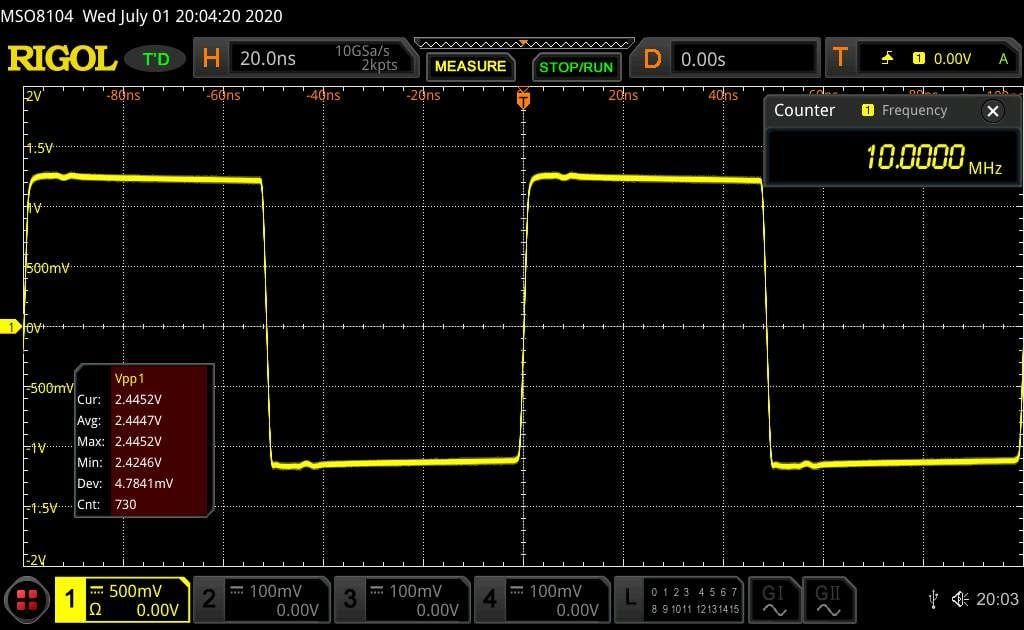    |
|
|
|
Post by misterc on Dec 18, 2020 9:42:59 GMT
Next set of images show a 50 ohm cable being fed a true 75 ohm signal to a 50 ohm receiver note the reduced PK<>PK voltage and difference in the top edge wave form.   |
|
|
|
Post by misterc on Dec 18, 2020 9:44:34 GMT
Now a genuine 75 ohm audio clock cable using the 50 feed into a 50 ohm receiver, as you can see plus the top edge definition again is greatly effected. 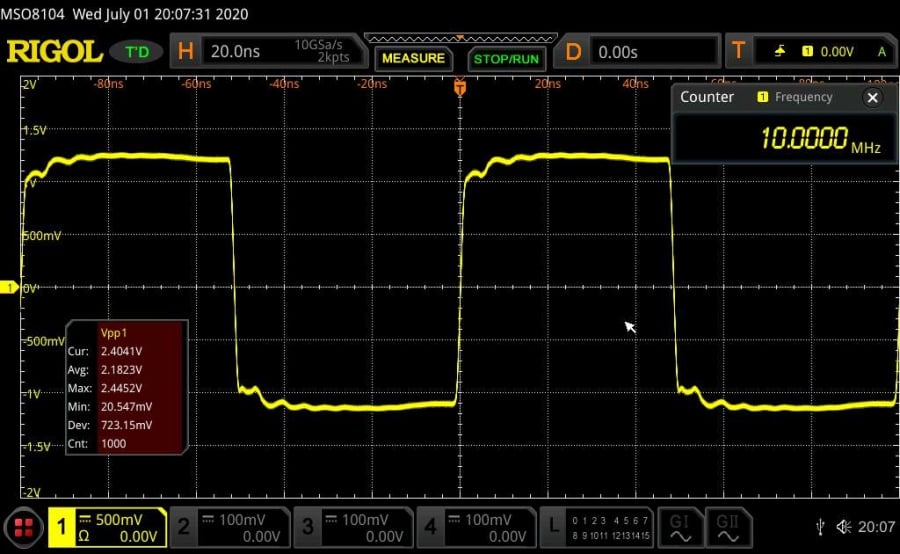 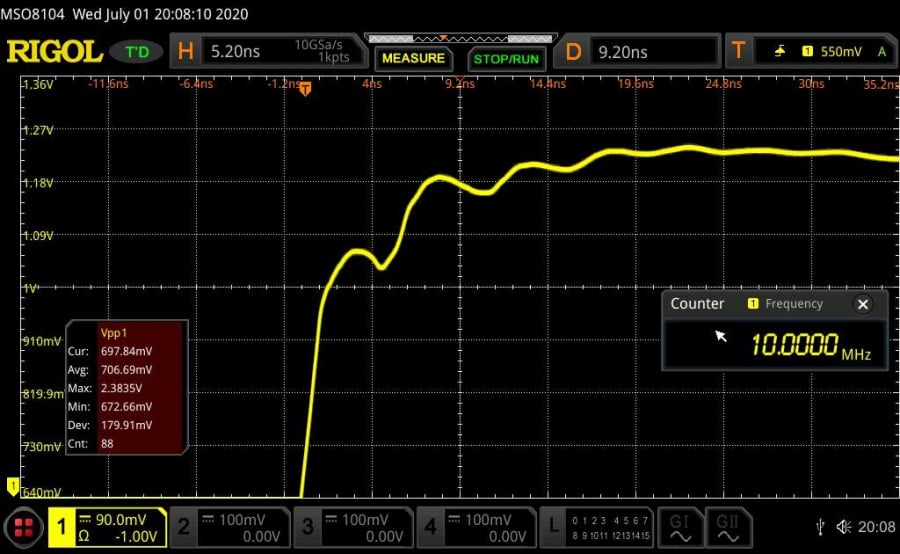 |
|
|
|
Post by misterc on Dec 18, 2020 9:47:31 GMT
|
|
|
|
Post by misterc on Dec 18, 2020 9:48:01 GMT
For the incoming data stream not to trigger either the wave form would have to be very badly distorted on the leading edge or the overshoot would need to be in the high double figures. another possible option could be the clock recovery circuit being of mediocre design with fairly high corner stone frequency and very average PLL ability this would lead to issues and a large increase in distorted sounds if not drop outs so pretty rare for this situation to happen
Yes the alignment of the audio data to word bit data would not be ideal at all, simply as the main timing (derived from the word clocking circuitry) would be sub optimal and therefore an increase in time interval error (TIE) would occur with out question
Any wave form deviation from the normal incoming wave form that point the circuit would usually see during normal operations can result in an in jitter.
These deviations are cause by the following:-
TRANSMISSION LINE problems, impedance mis-matching all the whole line no just the cables or board connectors, circuit board embedded pathways, components in that circuit where inductors capacitors or resistors.
BANDWIDTH data line not being sufficiently capable of handling the full amount of transmitted data remember audio word clocks are a staple 10Mhz so a pretty low level data stream required, however if all of the those components that make that pathway are not up to the task then jitter will occur. We use a tool called an eye diagram to look at serial data transmission lanes and can determine by observing the decoded patterns where a great many issues actually line in the circuit.
CROSSTALK pretty obvious where other signals which should be totally isolated from the clocking sections of device actually interferes with the clock for data circuit that is connected to the clock causing introduced noise which leads to unwanted induced jitter
Data generated jitter which is caused by bad programming at the core cpu or PFGA etc this can generate ISI (intersymbal interference) induced jitter and duty cycle distortion this is quite common in either highly complex devices where a lot of processing power is required to run a device and it takes a long time for total debug or in a simple device with novice programmer skills
We have special seial data analysis tools to look at all these types of jitter problems more on that later
RANDOM NOISE
which is cause by thermal flunctations the higher the temperature the more jitter.
This next one can be difficult to understand ,shot noise which is the random movement of electrons within the circuit like black holes and large celestial bodies mbe moved by dark matter not a lot you can do to take into account for this issue!
Lastly in this section frequency noise or pink noise the lower the frequency the more noise is introduced into the design all if these items designs take into account when coming up with a new product so tradeoffs are going to happen
All of the above cited problems can cause data line data corruption problems which will lead to the Rx end of your data stream incorrectly reading the edge crossing if the data which will result in jitter factor of electronics life.
There are more items that need addressing with jitterwe have just touched on the surface however that is for a later post.
|
|
|
|
Post by misterc on Dec 18, 2020 9:52:39 GMT
Thinking about at the above posts I should have constructed a finial post to condense this information into bullet points. Ideal conditions:-
Zero compromise:-
Transmission 50 Ohm output <> 50 Ohm Cable <> 50 Ohm receive end terminal
Transmission 75 Ohm output <> 75 Ohm Cable <> 75 Ohm receive end terminal
Not so good:-
Transmission 50 Ohm output <> 75 Ohm Cable <> 50 Ohm receive end terminal
Transmission 75 Ohm output <> 50 Ohm Cable <> 75 Ohm receive end terminal Transmission 75 Ohm output <> 75 Ohm Cable <> 50 Ohm receive end terminal
Transmission 50 Ohm output <> 75 Ohm Cable <> 75 Ohm receive end terminal Least desirable:-
Transmission 50 Ohm output <> 75 Ohm Cable <> 50 Ohm <> 75 Ohm adapter at receive end terminal
Transmission 75 Ohm output <> 75 Ohm Cable <> 75 Ohm <> 50 Ohm adapter at receive end terminal
What you are attempting to achieve is removing as many of the reflection pathways as possible in the same way in your audio system you are trying to remove as much, electrical, mechanical, vibrational and radio reference noise as possible. You make a comment on one of the results where the using a 75 Ohm cable on the 50 Ohm Tx & Rx positions resulted in a not too dissimilar wave form than the ideal impedance matched example. Later on I will delve onto some jitter analysis with eye diagrams to illustrate that even small amounts of deviation will not yield the desired outcome. Also show how an ok looking square wave form can in fact had a multitude of sins. Having spent a lot of years with this subject and many digital audio projects I can safely and happily share my thoughts, you can quite easily determine an impedance mismatch digital audio cable against the correctly matched item. With clock cables this can manifest itself as less than ideal sound staging, more diffuse vocal placement, the timing is less coherent with an overall sense if it's not quite correct. For those of you that use a a word clock and have genuine impedance matched cables, just try changing it for say a normal analogue cable of the same termination or a 50Ohm lab cable. Let us know what you feel. Sorry back to the subject of adapters an issue personally I will not compromise on in any form in my professional and audio life. Yesterday I received a large delivery of supplies for a new project I am working on and along with the components with another small box inside was pair of matching 50<>75 balun's BNC terminated for another project which has been on the back burner due to myself needing to construct a test rig for characterizing insertion loss for a/c mains common mode filters. This means I have how some rather decent 50<>75 Ohm isolation transformers so this may work out to an acceptable compromise for some individuals. These are NOT audio products but genuine lab test standard isolation transformers with impedance transitions by a company called North Hills if I have time today I will test it for you. Below is wave form analysis of a Mutec MC3+ in word clock output mode using 176.4Khz files this will give you an idea of how some smaller companies and individuals actually go into deeper investigations with there research and designing stages for their products I suspect Uptone have this philosophy as well.  |
|
|
|
Post by misterc on Dec 18, 2020 9:58:20 GMT
Also as well as wave form ringing and reflections note the difference in amplitude and positive and negative waveform widths.  |
|
|
|
Post by macca on Dec 18, 2020 12:36:43 GMT
Yes but the adapters to RCA aren't 75 ohm and can never be. The discontinuity in impedance causes reflections in high frequency signals. The physical dimensions of the RCA connector cannot dictate a 75 ohm impedance, it is a lot lower. So, what's the Answer? use optical instead. Connect both optical and coax and then, before starting playback, randomly flick between the outputs on the remote several times without looking at the display (ideally cover the display) so you don't know which is selected, then start listening and toggle between them at your leisure. Marvel at the way the previously heard 'big differences' between the two are now impossible to discern. |
|
Bigman80
Grandmaster
 The HiFi Bear/Audioaddicts/Bigbottle Owner
The HiFi Bear/Audioaddicts/Bigbottle Owner
Posts: 16,398
|
Post by Bigman80 on Dec 18, 2020 13:08:15 GMT
use optical instead. Connect both optical and coax and then, before starting playback, randomly flick between the outputs on the remote several times without looking at the display (ideally cover the display) so you don't know which is selected, then start listening and toggle between them at your leisure. Marvel at the way the previously heard 'big differences' between the two are now impossible to discern. I could try that. |
|
|
|
Post by macca on Dec 18, 2020 13:27:43 GMT
Try it, I couldn't discriminate between them in my set up either blind or sighted.
I have had a couple of drop-outs using coax, literally just a couple over a couple of hundred hours of listening, but one is too many.
is USB also an option?
|
|
Bigman80
Grandmaster
 The HiFi Bear/Audioaddicts/Bigbottle Owner
The HiFi Bear/Audioaddicts/Bigbottle Owner
Posts: 16,398
|
Post by Bigman80 on Dec 18, 2020 14:51:27 GMT
Try it, I couldn't discriminate between them in my set up either blind or sighted. I have had a couple of drop-outs using coax, literally just a couple over a couple of hundred hours of listening, but one is too many. is USB also an option? USB is an option but i am loathed to use it. Seems there is light at the end of the tunnel: A post from Soren on "Super Audio Best Friends" "There is an issue with some of the early dac1541s, the sensitivity on the Coax/RCA SPDIF is a little low. AES is fine, so is Toslink and of course USB.
Upgrading to firmware 1.20 will improve a little, but I can also offer a hardware upgrade. Anybody who have an early dac1541 who wished to have it upgraded, send an email to info@soekris.dk for instructions"Iam now suspecting my 1421 may have an issue too. I have now made contact with Soren (Soekris) and he has advise me to return the DAC to factory settings and also informed me that there is a new Firmware update available which should be easy to perform. I will try these first and see if they resolve the issue. I am very happy with the performance of both the Soekris and the N15D and i am loathed to relinquish either unit over this matter, especially as it seems the N15D is not at fault. I will go back to TOS and see what happens between the two, too. |
|


 This track.......where has this come from?
This track.......where has this come from?






